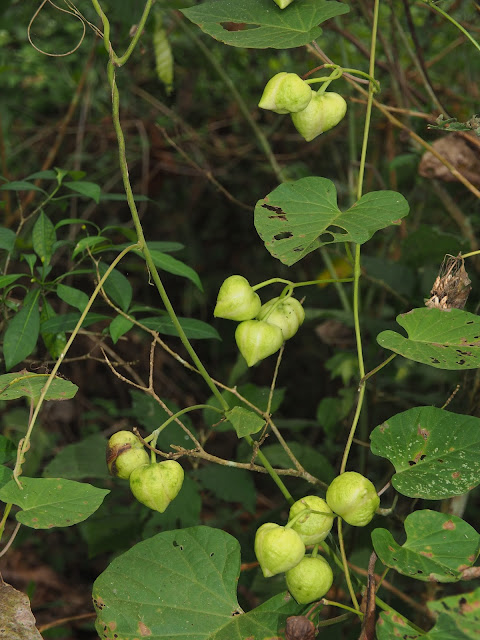This morning it says the Heat Index is 39°C, can you feel that! Those used to winter climates will die in hearing they will be put in that temperature. The funny part is that our Weather Bureau is not officially announcing that we are already in our Dry Season, because some easterlies are still at the northernmost-eastern part of the country. HI of 39C was experienced last year in April, when we are already tense waiting for the first rains, that might alleviate the heat. So it was advanced by 2 months. I can't imagine what it would be like next year and the succeeding years. Please help us God!
Anyway, back to business. The good thing is that our vegetation continues to be green and flowering, except for the annuals of course. They are now dried or wilted because some clayey soils are already cracking from dehydration.
Flemingia strobilifera was posted still purely green last month, now it is already maturing and dry. Those shrimp-like structures already have mature seeds ready again for the coming rainy season. This is not in the garden but in the adjacent property.
Even this Grey Glassy Tiger might have difficulty looking for nectar plants
Locally called Tagpo, Psychotria luzoniensis (not sure ID), is a medium sized bush that is growing under the trees. It offers flowers for butterflies during the wet season and now the fruits mature into golden berries eaten by birds.
the tagpo plant with ripe fruits
This Ipomoea sp. vine with lavender flowers now have plenty of maturing fruits,
again trying to be ready for the rainy season in May-June.
These are also flowers under the bushes, also visited by butterflies.
The first is pandakaki and the 2nd i still don't know.
This is now in our garden, Dracaena surculosa, with very sweet fragrant blooms
that open early in the evening. The scent resembles some sweet hoya.
Impatiens balsamina at the last vestiges of reproduction
first flowering of the volunteer Pentas lanceolata
the ever heat happy bougainvillea, when others dry they still bloom
my self supporting Vanda sp. trying to catch attention
a vine from the wild but domesticated in my garden, butterfly pea or Clitoria ternatea
The biggest hoya bloom found in my garden, Hoya imperialis,
which i haven't seen when it opened
Hoya mindorensis being visited by a moth and a cricket at night.















Great blooms! Our summer heat and humidity will be here shortly. We've already had some of it, but are being blessed with another bout of gorgeous weather with it being in the 50's F. during the night.
ReplyDeleteHave a great week ~ FlowerLady
Even if your summer is with high RH, it is still milder than ours, good for you!
DeleteMany of us share your alarm at the climate changes in our world .... hopefully the temperatures do moderate for you .... in the meantime, thank you for sharing the lovely blooms and the wildlife!
ReplyDeleteImagine we are not yet officially in our Dry Season! Our power consumption geometricaly rise these months!
DeleteThese are really interesting plants and flowers, many of which are unfamiliar. Thank you for sharing your tropical paradise!
ReplyDeleteHow fabulous!
ReplyDeleteEverything is lovely. With the heat in early morning, I have a solution. Eat halo halo for breakfast.
ReplyDeleteYes that is probably a solution, but only for the mouth.Our power consumptions geometrically rise these months!
DeleteGorgeous blooms, but I think I would surely expire in that heat!
ReplyDeleteHahaha yes, people from temperate climates will evaporate with this heat! In contrast, those of us living in this heat all our lives will freeze dead in your negative temperatures!
DeleteSo much beautiful greenery and such lovely flowers. I feel like we're seeing the effects of climate change where I live too, we didn't have much of a winter this year.
ReplyDeleteBeautiful photos, all of them!
ReplyDeleteYour vanda could even steal my heart away from my beloved bougainvillea.
Kay
An Unfittie's Guide to Adventurous Travel
Our climate will get heated up in coming months till its spring here,its fascinating to see some of our summer - monsoon blooms in that part of your region like crape jasmine,clitoria or locally known as aparajita
ReplyDelete